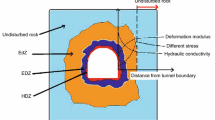Abstract
During slope excavation, high stresses can become concentrated in the rock mass because of stress redistribution. Failure of the rock mass creates an excavation-damaged zone (EDZ) in the slope. The damage reduces the acoustic wave velocity in the rock mass. Results of field tests measuring acoustic wave velocity at the Jinping I Hydropower Station are used here to study the EDZ in a tall rock slope. Two acoustic testing methods were adopted in the field tests: single-hole acoustic testing (SAT) and cross-hole acoustic testing (CAT). The acoustic wave velocity was lower in the EDZ, and the depth of the EDZ increased with decreasing slope elevation. Statistical analysis shows that the acoustic wave velocity obtained by the SAT method is larger than that obtained by the CAT method, and the relative difference between the SAT- and CAT-derived velocities is lower for a high quality rock mass than for a low quality rock mass. The integrity ratio and severity of damage can also be determined by acoustic wave velocity test results, revealing that the integrity ratio and elastic modulus of a rock mass are reduced in the EDZ.











Similar content being viewed by others
References
Balland C, Morel J, Armand G, Pettitt W (2009) Ultrasonic velocity survey in Callovo-Oxfordian argillaceous rock during shaft excavation. Int J Rock Mech Min Sci 46(1):69–79
Barton N (2007) Rock masses, seismic velocity, attenuation and anisotropy. Taylor & Francis, London
Brideau MA, Yan M, Stead D (2009) The role of tectonic damage and brittle rock fracture in the development of large rock slope failures. Geomorphology 103(1):30–49
Castro-Fresno D, Lopez QL, Blanco-Fernandez E, Zamora-Barraza D (2009) Design and evaluation of two laboratory tests for the nets of a flexible anchored slope stabilization system. Geotech Test J 32(4):315–324
Chang SH, Lee CI, Lee YK (2007) An experimental damage model and its application to the evaluation of the excavation damage zone. Rock Mech Rock Eng 40(3):245–285
Cheon DS, Jung YB, Park ES, Song WK, Jang HI (2011) Evaluation of damage level for rock slopes using acoustic emission technique with waveguides. Eng Geol 121(1–2):75–88
Donnelly LJ, Culshaw MG, Hobbs PRN, Flint RC, Jackson PD (2005) Engineering geological and geophysical investigations of a slope failure at Edinburgh Castle, Scotland. Bull Eng Geol Environ 64(2):119–137
GB 50487-2008, Chinese Standard (2008) Code for engineering geological investigation of water resources and hydropower, Beijing (in Chinese)
Golshani A, Oda M, Okui Y, Takemura T, Munkhtogoo E (2007) Numerical simulation of the excavation damaged zone around an opening in brittle rock. Int J Rock Mech Min Sci 44(6):835–845
HydroChina Chengdu Engineering Corporation (2007) Report of selecting dam site for Jinping first stage hydropower station, part 4: engineering geological condition. Chengdu, China, pp 15–38 (in Chinese)
Kwon S, Lee CS, Cho SJ, Jeon SW, Cho WJ (2009) An investigation of the excavation damaged zone at the KAERI underground research tunnel. Tunn Undergr Sp Technol 24(1):1–13
Lai XP, Cai MF, Ren FH, Xie MW, Esaki T (2006) Assessment of rock mass characteristics and the excavation disturbed zone in the Lingxin Coal Mine beneath the Xitian river, China. Int J Rock Mech Min Sci 43(4):572–581
Malmgren L, Saiang D, Töyrä J, Bodare A (2007) The excavation disturbed zone (EDZ) at Kiirunavaara mine, Sweden—by seismic measurements. J Appl Geophys 61(1):1–15
Martino JB, Chandler NA (2004) Excavation-induced damage studies at the Underground Research Laboratory. Int J Rock Mech Min Sci 41(8):1413–1426
Saiang D, Nordlund E (2009) Numerical analyses of the influence of blast-induced damaged rock around shallow tunnels in brittle rock. Rock Mech Rock Eng 42(3):421–448
Schuster K, Alheid HJ, Boddener D (2001) Seismic investigation of the excavation damaged zone in Opalinus clay. Eng Geol 61(2–3):189–197
Sheng Q, Yue ZQ, Lee CF, Tham LG, Zhou H (2002) Estimating the excavation disturbed zone in the permanent shiplock slopes of the Three Gorges Project, China. Int J Rock Mech Min Sci 39(2):165–184
Wassermann J, Sabroux JC, Pontrreau S, Bondiguel S, Guillon S, Richon P, Pili E (2010) Characterization and monitoring of the excavation damaged zone in fractured gneisses of the Roselend tunnel, French Alps. Tectonophysics 503(1–2):155–164
Wong LNY, Einstein HH (2009) Using high speed video imaging in the study of cracking processes in rock. Geotech Test J 32(2):164–180
Wu FQ, Liu JY, Liu T, Zhuang HZ, Yan CG (2009) A method for assessment of excavation damaged zone (EDZ) of a rock mass and its application to a dam foundation case. Eng Geol 104(3–4):254–262
Zhou JW, Xu WY, Yang XG (2010) A microcrack damage model for brittle rocks under uniaxial compression. Mech Res Commun 37(4):399–405
Acknowledgments
This paper was supported by the National Natural Science Foundation of China (41102194 and 51209156), the Science Foundation for Excellent Youth Scholars of Sichuan University (2013SCU04A07) and the China Postdoctoral Science Foundation (2012T50785). Critical comments by the anonymous reviewers greatly improved the initial manuscript.
Author information
Authors and Affiliations
Corresponding author
Rights and permissions
About this article
Cite this article
Zhou, Jw., Yang, Xg., Xing, Hg. et al. Assessment of the Excavation-Damaged Zone in a Tall Rock Slope Using Acoustic Testing Method. Geotech Geol Eng 32, 1149–1158 (2014). https://doi.org/10.1007/s10706-014-9767-2
Received:
Accepted:
Published:
Issue Date:
DOI: https://doi.org/10.1007/s10706-014-9767-2




